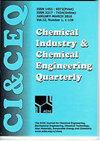微繁罗勒薄层干燥的研究:基于推导方程、质量特性和能量效率的建模
IF 0.8
4区 工程技术
Q4 CHEMISTRY, APPLIED
Chemical Industry & Chemical Engineering Quarterly
Pub Date : 2023-01-01
DOI:10.2298/ciceq220722003k
引用次数: 1
摘要
本文介绍了微繁罗勒薄层干燥的建模、干燥产品的一些品质特性以及所使用的干燥机的能耗分析。在统计分析中,使用了前人文章中获得的实验干燥数据。利用实验数据,在风速为1m /s、温度为30-50℃的条件下,进行了模型研究统计。统计分析结果表明,在所有温度下,Verma方程是具有最低卡方值和AIC值的最佳拟合模型。通过对导出的干燥模型进行统计分析,发现D9方程的?2值为0.0146,AIC值为-528.022是最适合实验数据的模型。测定了罗勒干样品的总酚含量、类黄酮含量和抗氧化能力为2.538 ?0.029 mg GAE/g, 2.017 ?0.088 mg槲皮素/g, 2.263 ?0.001 mmol TEAC/100 g DW。从红外光谱上看,罗勒干样具有典型的官能团。扫描电镜图像显示,叶片表面发生了塌陷。但是,这种塌陷并不影响叶片表面的官能团。通过能耗分析,优选出最佳干燥温度为40℃。SMER、MER和SEC值是根据能耗分析在40?C分别为0.0043 kg/kWh、0.0007 kg/h和234.81 kWh/kg。本文章由计算机程序翻译,如有差异,请以英文原文为准。
Investigation of the thin layer drying of micropropagated Ocimum basilicum L: Modeling by derived equations, quality characteristics, and energy efficiency
This study presents modeling of thin layer drying of micropropagated O. basilicum L., some quality characteristics of dried product, and energy consumption analysis for the dryer used. In the statistical analyses, the experimental drying data obtained from a previous article were used. Modeling studies were statistically carried out using the experimental data at 1 m/s airflow rate and at the temperature of 30-50?C. The statistical analysis results showed that Verma equation was the best fit model having the lowest chi-square (?2) and AIC values at all temperatures studied. From statistical analyses using derived drying models, it was found that D9 equation having ?2 value of 0.0146 and AIC value of -528.022 was the best model fitting to experimental data. The total phenolic content, flavonoid, and antioxidant capacity of dried basil samples were measured as 2.538 ? 0.029 mg GAE/g, 2.017 ? 0.088 mg quercetin/g, and 2.263 ? 0.001 mmol TEAC/100 g DW, respectively. From FTIR spectra, dried basil samples had typical functional groups. SEM images showed that a collapse in the surface of the leaves occurred. But, this collapse is not affect the functional groups of the surface of the leaves. From energy consumption analyses, optimum drying optimum drying temperature was found to be 40?C. The SMER, MER, and SEC values calculated from energy consumption analysis at 40?C were 0.0043 kg/kWh, 0.0007 kg/h, and 234.81 kWh/kg, respectively.
求助全文
通过发布文献求助,成功后即可免费获取论文全文。
去求助
来源期刊

Chemical Industry & Chemical Engineering Quarterly
CHEMISTRY, APPLIED-ENGINEERING, CHEMICAL
CiteScore
2.10
自引率
0.00%
发文量
24
审稿时长
3.3 months
期刊介绍:
The Journal invites contributions to the following two main areas:
• Applied Chemistry dealing with the application of basic chemical sciences to industry
• Chemical Engineering dealing with the chemical and biochemical conversion of raw materials into different products as well as the design and operation of plants and equipment.
The Journal welcomes contributions focused on:
Chemical and Biochemical Engineering [...]
Process Systems Engineering[...]
Environmental Chemical and Process Engineering[...]
Materials Synthesis and Processing[...]
Food and Bioproducts Processing[...]
Process Technology[...]
 求助内容:
求助内容: 应助结果提醒方式:
应助结果提醒方式:


